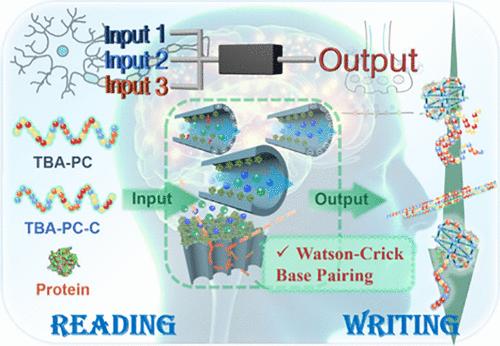受生物记忆启发的凝血酶纳米通道逻辑门
IF 6.7
1区 化学
Q1 CHEMISTRY, ANALYTICAL
引用次数: 0
摘要
生物记忆中的“读”和“写”过程涉及神经元之间的电信号传递,配体门控离子通道起着关键作用。固态纳米通道与神经元有某些相似之处。信息传输可以通过控制纳米通道内离子的流动来实现,这使得纳米通道可能适用于模拟神经元的行为。本文选择凝血酶(Thr)作为靶蛋白,利用DNA适配体成功构建了功能化纳米通道传感系统,实现了高灵敏度的Thr响应,检测限为0.221 fM。同时,基于Watson-Crick碱基配对和可编程链位移反应,进一步实现了靶分子的可控释放和循环响应。该机制阐明了控制特定输入输出关系的规则,并通过3纳米通道逻辑门创新地将它们与记忆存储和识别联系起来,从而实现了硬件层面的生物记忆读取。综上所述,本发明的生物混合纳米流体控制装置将分子事件转化为电信号,为未来建立生物记忆与固态纳米通道生物传感和识别机制之间的联系提供了潜在的途径。本文章由计算机程序翻译,如有差异,请以英文原文为准。

Thrombin Nanochannel Logic Gate Inspired by BioMemory
The process of “reading” and “writing” in biomemory involves the transmission of electrical signals between neurons, with ligand-gated ion channels assuming a key role. The solid-state nanochannels exhibit certain similarities with neurons. Information transmission can be achieved by controlling the flow of ions within nanochannels, rendering them potentially suitable for simulating neuron behavior. Herein, thrombin (Thr) was chosen as the target protein, and a functionalized nanochannel sensing system was successfully constructed using DNA aptamers, enabling a highly sensitive Thr response with a detection limit of 0.221 fM. Simultaneously, based on Watson–Crick base pairing and programmable chain displacement reactions, controlled release and cyclic response of the target molecule were further achieved. This mechanism elucidates the rules governing specific input-output relationships, innovatively linking them with memory storage and recognition through the Thr-nanochannel logic gate, thereby realizing the reading of biomemory at the hardware level. In summary, the biological hybrid nanofluidic control device of this invention converts molecular events into electrical signals, providing potential avenues for establishing connections between the mechanisms of biomemory and solid-state nanochannel biosensing and recognition in the future.
求助全文
通过发布文献求助,成功后即可免费获取论文全文。
去求助
来源期刊

Analytical Chemistry
化学-分析化学
CiteScore
12.10
自引率
12.20%
发文量
1949
审稿时长
1.4 months
期刊介绍:
Analytical Chemistry, a peer-reviewed research journal, focuses on disseminating new and original knowledge across all branches of analytical chemistry. Fundamental articles may explore general principles of chemical measurement science and need not directly address existing or potential analytical methodology. They can be entirely theoretical or report experimental results. Contributions may cover various phases of analytical operations, including sampling, bioanalysis, electrochemistry, mass spectrometry, microscale and nanoscale systems, environmental analysis, separations, spectroscopy, chemical reactions and selectivity, instrumentation, imaging, surface analysis, and data processing. Papers discussing known analytical methods should present a significant, original application of the method, a notable improvement, or results on an important analyte.
 求助内容:
求助内容: 应助结果提醒方式:
应助结果提醒方式:


